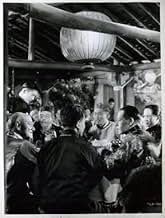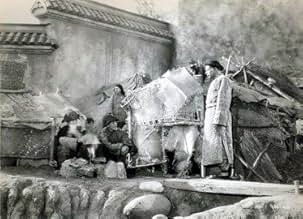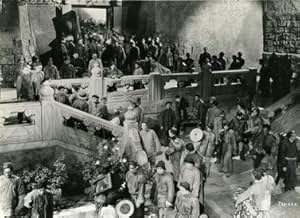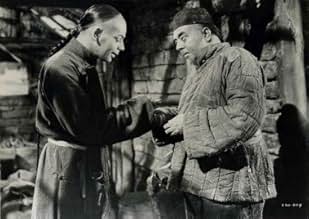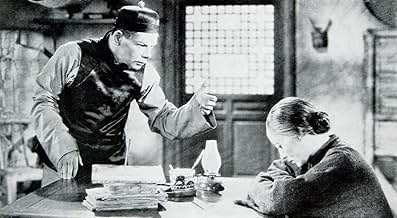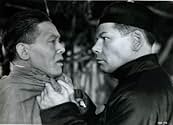Bien que les fermiers chinois mariés Wang et O-Lan connaissent d'abord le succès, leurs vies sont compliquées par des fortunes déclinantes et des périodes de vaches maigres, ainsi que par l'... Tout lireBien que les fermiers chinois mariés Wang et O-Lan connaissent d'abord le succès, leurs vies sont compliquées par des fortunes déclinantes et des périodes de vaches maigres, ainsi que par l'arrivée de la belle jeune Lotus.Bien que les fermiers chinois mariés Wang et O-Lan connaissent d'abord le succès, leurs vies sont compliquées par des fortunes déclinantes et des périodes de vaches maigres, ainsi que par l'arrivée de la belle jeune Lotus.
- Récompensé par 2 Oscars
- 7 victoires et 3 nominations au total
- Revolutionary Army Captain
- (non crédité)
- Man
- (non crédité)
- Teahouse Dancer
- (non crédité)
- Chinese Girl
- (non crédité)
Avis à la une
I was particularly impressed by the camera work and the use of crowd scenes, especially during the sacking of the palace where O-Lan was once a slave. The graphic and grim atmosphere of the firing squad and the drought made this an epic quite unlike others of the same time where it was all glitz and glitter. I watched this film from beginning to end enthralled. I can't say the same for the "epics" of today.
This was the first movie I saw at New York's Museum of Modern Art, around 1970 (I was a teenager). Expensive looking yet with scenes of such poverty, masterfully photographed, often thrilling, and always engaging, to me it was MGM movie-making at its best. What did audiences feel when they glimpsed a locust attack, the person by person destruction of a mansion, the horrific poverty and then the splendor of wealth.
Last week, those watching the Academy Awards had a glimpse of the "senior" Oscar winner in attendance, Luise Rainer. How grand to see an actress who arguably delivered one of the most masterful, haunting performances in history electing to return for a celebration.
Ok, so she should not have won the year before (Great Ziegfeld), but don't blame Luise. Talkies were only a decade old when this was released, and her dialogue limited. But as Olan, her use of visual and vocal is memorable.
Large scale and touching, what more could a movie lover want!
For those people who thought "The Good Earth" was dull and not entertaining, I have nothing to say. They are entitled to their opinion, but they missed one of life's most important lesson's: Humility and loyalty.
I was fortunate to see this film when it was FIRST released - in 1939. It's wonderful story (Pearl S. Buck) written for film (Talbot Jennings) has stayed with me all through my long life. I saw it in a theater then; I found it in the "garbage bin" in Wal-Mart this year (2011) and bought it immediately....I had it in a huge collection I gave to a library in Los Angeles when I moved to Florida. The copy I have now was made from the original cut - there are black screens between big scenes. I don't remember that after all these years, but accept it was the way the early release looked. It doesn't bother me - it gives me more time to think of what I have just viewed and anxious to see what's next. To me, the story is so engrossing the length of the film doesn't even occur to me - I would have liked the ending to be longer, because "Olan, you are the earth" told the entire reason for the story of true love and devotion, to the extreme.....
I'm not even bothered by the question so many people asked of why Paul Muni ("Wang Lung") and Luise Rainer ("Olan") were cast instead-of Asians - I had never seen Ms. Rainer in any film, and have no idea why her Hollywood career faded. She was considered to be a great beauty. Paul Muni I've seen in other films, but he wasn't one of my favorites. Yes, I have always wondered how "Gone with the Wind" - beat it out of an award: actually, I thought "The Good Earth" was filmed in color. Now, I'm not even concerned about that - the STORY, the ultimate entirety of the film's huge scenes and huge cast dismisses any negative comment I could think of, or read.
Walter Connolly ("Uncle") and Charlie Grapewin ("Old Father") were perfectly cast and played their roles with great skill. All of the cast were consummate in their roles; director Sidney Franklin held a strong grip of the totality of the film and got it all right. As time progressed into a more modern era, the characters became more modern: except, "Olan" stayed the wonderful woman she was.
However - Ms. Rainer stole the entire movie. A good actress does not always need words to say. I feel the story of a peasant-farmer and his ex-slave wife, all of the troubles they encountered (and defeated), the entire cast presented an accurate portrayal of the story in those days - China. It is hard for me to visualize any re-make could be better, and feel any CGIs would be completely unnecessary. It is also hard for me to realize China's last emperor was alive when I went to Hawai'i in 1969......living a peasant-life, just as did "Wang Lung" and "Olan".
Anyone who views "The Good Earth" and doesn't readily understand that life is bigger than any of us, haven't really lived. It gets a 20 from me - I recommend it to every living soul.
The story begins on the wedding day of Wang Lung (Paul Muni), a kind and gentle farmer. His wife, O-Lan (Luise Rainer), bears his sons and quietly encourages him to pursue his dreams, no matter what sacrifices they entail from her. The family lives through a famine and finally achieves prosperity and success. However, with success comes greed and corruption, and soon Wang is buying large plots of land and the Great Hall at which O-Lan was a servant. Eventually, he takes a second wife and breaks ties with all who were once close to him. It takes a tragedy for him to see the error of his ways.
All the while O-Lan stands behind him, supporting every decision he makes in her own tranquil way. Rainer's Oscar winning portrayal, like O-Lan herself, is the glue that holds the story together. Muni, often prone to hamminess in his work, shows restraint here and contributes a beautiful, multifaceted performance. The cinematography, which also received an Oscar, is excellent, as are the special effects. A sequence which involves locusts, invading the crops by the million, is nothing short of unforgettable. It is storytelling in the grandest sense of the word, with strong characterizations, high production values, and an engrossing story which more than justifies `The Good Earth's status as a classic.
Le saviez-vous
- AnecdotesSpecial effects experts were unable to produce an authentic-looking locust plague. Just as they were about to abandon the scene, they received word that a real locust plague was taking place several states away. A camera crew was rushed to the scene to capture it on film.
- Gaffes(at around 2h 5 mins) Wang Lung is walking through the locust storm in his wheat field. He picks up a few men who have fallen down into the thick pile of locusts. In frustration, Wang shouts "I said save the wheat! Save it!" At this moment, a man dressed in 1937-era American clothing walks across the scene from left to right, at the top third of the screen. He is wearing a white hat and appears to be smoking a cigarette or cigar held in his left hand.
- Citations
Wang Lung: [must sell his land to feed his family but the buyers take advantage of him] Thieves! Thieves! And well you know I must sell.
O-Lan: No! Not the land. We'll not sell the land. We'll keep it. We'll go south and when we return, we'll still have the land.
Uncle: But I've arranged it. I brought these men here. You MUST sell!
O-Lan: Is it your land? Did you buy it bit by bit? The land is our life... and it's better to go south... or die walking... than to give it to you for nothing.
- Crédits fousIntroduction played with opening credits: The soul of great nation is expressed in the life of its humblest people. In this simple story of a Chinese farmer may be found something of a the soul of China - its humility, its courage, its deep heritage from the past and its vast promise for the future.
- ConnexionsEdited into Les Fils du dragon (1944)
Meilleurs choix
Détails
- Date de sortie
- Pays d’origine
- Site officiel
- Langue
- Aussi connu sous le nom de
- Visages d'Orient
- Lieux de tournage
- Cedar City, Utah, États-Unis(backgrounds for locust sequence)
- Société de production
- Voir plus de crédits d'entreprise sur IMDbPro
Box-office
- Budget
- 2 800 000 $US (estimé)
- Durée
- 2h 18min(138 min)
- Rapport de forme
- 1.37 : 1



